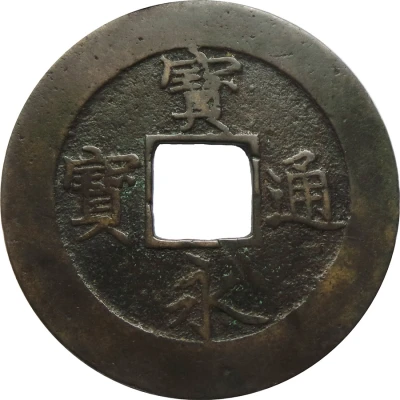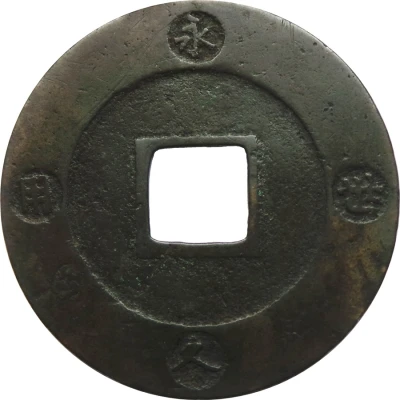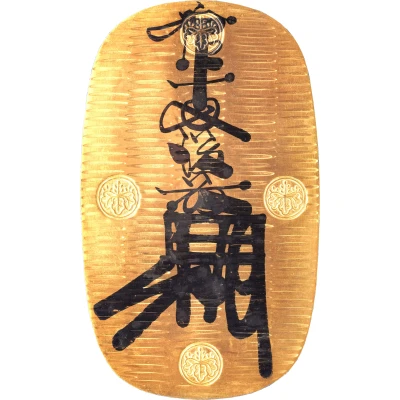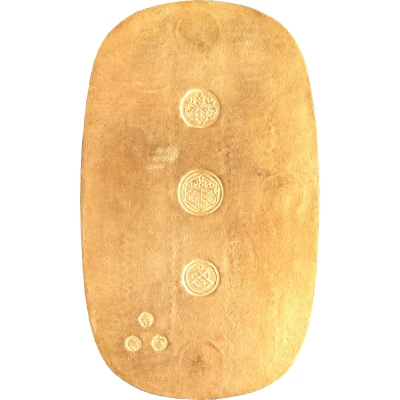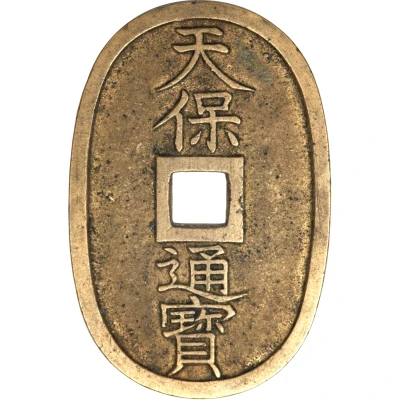
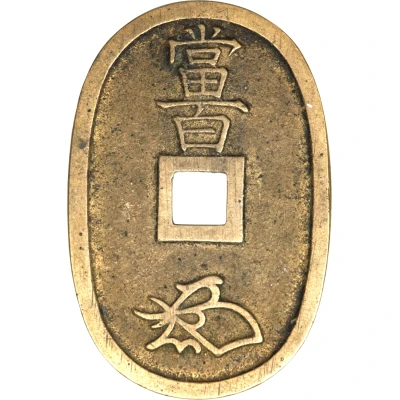

100 Mon "Tenpōtsūhō" ND
| Bronze (Cu 78%, Pb 12%, Sn 10%) | 20.7 g | - |
| Issuer | Japan |
|---|---|
| Emperor | Ninkō (1817-1846) |
| Type | Standard circulation coin |
| Years | 1835-1870 |
| Value | 100 Mon |
| Currency | Mon (683-1953) |
| Composition | Bronze (Cu 78%, Pb 12%, Sn 10%) |
| Weight | 20.7 g |
| Size | 49 mm |
| Thickness | 2.6 mm |
| Shape | Oval (With a square hole) |
| Technique | Cast |
| Orientation | Medal alignment ↑↑ |
| Demonetized | 31 December 1891 |
| Updated | 2024-10-06 |
| Numista | N#11614 |
|---|---|
| Rarity index | 12% |
Reverse
Value above hole and signature of the mint official below
Script: Chinese (traditional, regular script)
Lettering:
當
百
Translation:
Equal
Hundred
Edge
Smooth, paulownia stamps on the left and right side (various sizes and forms exist)
Comment
Many varieties exist:
Stamp varieties: LINK
Tenpōtsūhō was idea of Kinza to compete with Ginza's Kan'eitsūhō 4 Mon. The first lot was casted in 15 months period between 1835 and 1836, with a total of 29 710 700 pieces casted. The production was restarted again in mid-1837 and until 1842, additional 10 024 500 pieces casted. The Edo government gained 180 800 Ryō of profit for these cast.
The production was then restarted again in 1847 and in 1865, a new Zeniza was established in Nanba, Osaka, which casted the coin until 1868. After Meiji Restoration, the currency official of the new government restarted the cast, between 1868 and 1870, 63 913 752 pieces were casted. The total mintage since the first cast is 484 804 054 pieces.
Officially only produced in the mints of Honza in Edo and Osaka. However, because it was so profitable to make them, they were illegally cast in more than 10 provincial mints like Kurume, Satsuma, Fukuoka, Kochi, Yamaguchi, Aizu, Sendai, Akita and Morioka. Mito Domain was one that get permission to cast from Edo government.
Official coins were cast with very fine sand from Bosho and have a smooth field, unofficial casts used a much coarser sand and have much more grainy fields.
More than 586 740 000 pieces were withdrawn in Meiji period. The number exceeded the official mintage for more than a hundred million pieces. As not all coins were withdrawn, it is likely that more than 200 000 000 pieces of provincial issue were casted.
After the establishment of the modern currency system, this 100 mon coin was valued at only 8 Rin. Due to low value, less than 1 Sen compared to the size, and being in interchange of old and new era, the word Tenpōsen were used for describing outdated person or person that has incompability to develop themselves to the new era.
Exchanging for Yen currency started from December 1871, the Tenpōtsūhō stopped being legal tender on the 31st December Meiji 24 (1891) and stopped being exchanged for new currency at the end of Meiji 29 (1896).
Interesting fact
One interesting fact about the 100 Mon "Tenpōtsūhō" coin from Japan is that it was designed with a unique blend of metals, including copper (78%), lead (12%), and tin (10%). This distinctive composition was used to create a durable and long-lasting coin that could withstand the wear and tear of daily use. Despite its relatively small size and weight (20.7 grams), the coin was an important part of Japan's currency system during the Edo period and remains a valuable collector's item today.
Price
| Date | Mintage | VG | F | VF | XF | AU | UNC |
|---|---|---|---|---|---|---|---|
| ND (1835-1836) | 29710700 | - | - | - | - | - | - |
| ND (1835-1870) | 484804054 | - | - | - | - | - | - |
| ND (1837-1842) | 10024500 | - | - | - | - | - | - |
Values in the table are based on evaluations by sales realized on Internet platforms. They serve as an indication only for 100 Mon "Tenpōtsūhō" ND (1835-1870) coin.
